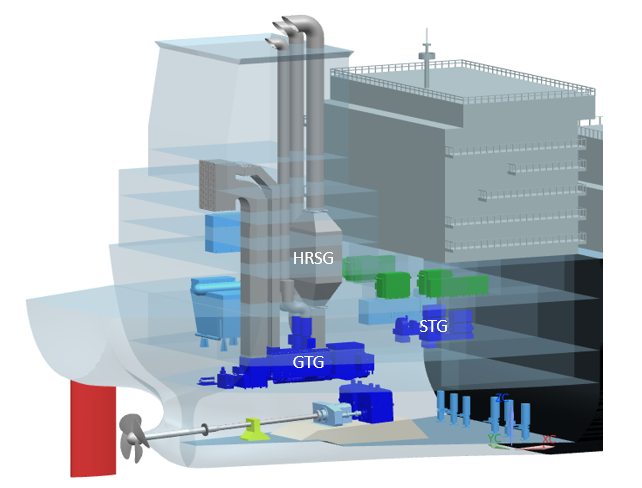GE’s Marine Solutions and Dalian Shipbuilding Industry Co. Ltd. (DSIC) completed a preliminary design for the conversion of a steam turbine powered LNG Carrier (LNGC) to a gas turbine-based propulsion system. The study aims at steam powered LNGCs that offer low fuel efficiency but are not ready to be retired from service. The new design will feature GE’s reliable and compact COmbined Gas turbine, Electric and Steam (COGES) system.
GE’s Brien Bolsinger, Vice President, Marine Operations, Evendale, Ohio, USA, said, “This feasibility study provides ship owners a competitive retrofit solution for 10 to 15 year-old steam-powered LNG carriers.”
According to Yingbin Ma, DSIC Deputy Technical Director, “A gas turbine’s smaller footprint allows for the minimum necessary conversion work required by the shipyard. By converting to a COGES power system, the fuel efficiency of the ship will be improved by 30 percent. This allows ship owners to increase the charter rate and win back opportunities in a market dominated by dual-fuel diesel engines. This study achievement is based on a 138,000 cubic meter LNGC powered by a steam turbine, but it can be applied on other similar size ships.”
Figure 1 shows the typical configuration for an LNGC retrofit with a GE COGES system. The steam generators and its auxiliary system will be kept to produce steam for power generation. This re-use of equipment helps reduce the total investment of the conversion. The existing diesel generator on the original ship will remain as the backup for the electric power system.
Shown in Figure 2 is the gas turbine generator (GTG) that sits on the third platform, while the steam turbine generators (STG) remain on the second platform. Thanks to the small footprint of the gas turbine, neither the engine casing nor the crew accommodations area need to be removed, which is inevitable if a larger sized diesel engine were to be installed.
Derived from GE’s CF6 family of aircraft engine, GE’s LM2500 family of aeroderivative gas turbines share the same proven jet engine technology with a field reliability of 99.9 percent. The LM2500 family includes the base LM2500 model (25 MW), LM2500+ (30 MW) and LM2500+G4 (35 MW). These same gas turbines are used onboard cruise ships, high speed yachts, fast ferries and offshore platforms, as well as by 35 navies worldwide. Three sizes of LM2500 gas turbines offer the flexibility to adapt the COGES power to a specific ship size and the ability to optimize performance. Equipped with a dry low emissions (DLE) combustor or a single annular combustor (SAC), a gas turbine can reduce nitrogen oxide (NOx) emissions to meet IMO Tier III/United States Environmental Protection Agency Tier IV requirements with no post combustion exhaust treatment.
Compared with two-stroke diesel engines, a gas turbine is 80 percent lighter and 30 percent smaller, according to GE. Featuring reduced weight, size – and using one of the existing steam turbines – COGES offers a simpler conversion that requires less dry dock time compared to a similar conversion with diesel engines, the manufacturer said.
In addition, GE said COGES offers customers lower lifecycle costs, including no pilot fuel, negligible lubricating oil consumption and simplified maintenance cost based on 50,000-hour overhaul interval with less than 300 maintenance related man-hours per year.




















